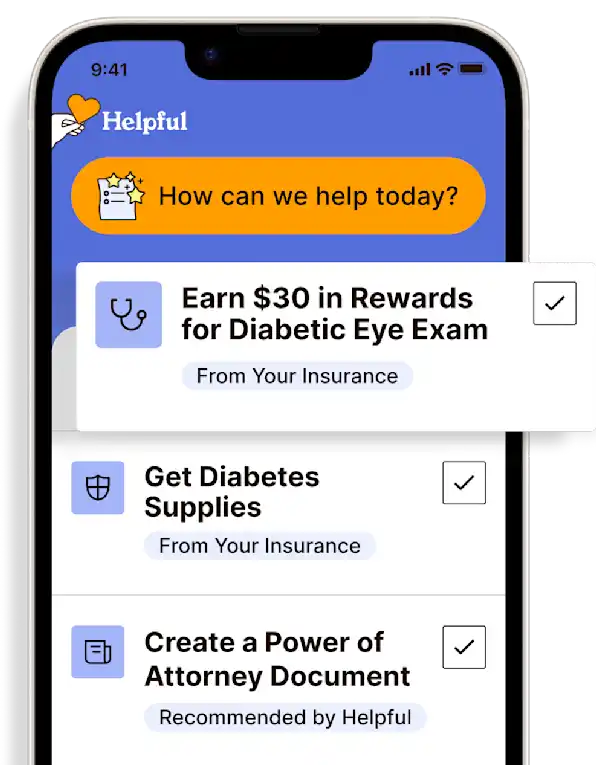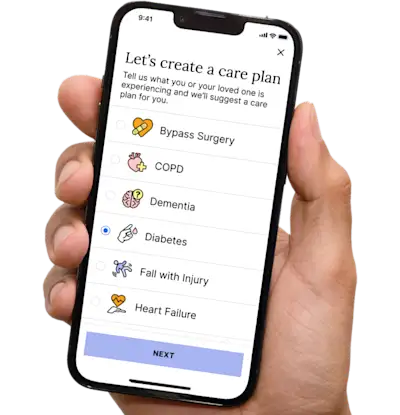Caregiving Challenges, Explaining "Aging in Place"
The simplest way to express aging in place is your loved one remaining independent, safe, and well in their own home as they age.
Get insurance benefits, legal documents, and medical records in one place

Helpful Highlights
"Aging in place" is your loved one aging in their own home, independently, safely, and well.
The first step is to observe them, their home, and them in their home.
The second step is to share your concerns and really listen to their response.
Develop a plan to help them stay in their home that involves household management and personal care considerations.
Your loved one may have already expressed to you that they want to stay in their own home, even though you may have concerns about safety, managing appointments and errands, and other activities of daily living. The good news is that with a good plan and the right help, your loved one may be able to remain at home.
Aging in place
Generally refers to continuing to live in the community, with some level of independence, rather than in residential aged care. While that doesn't necessarily mean staying in the same house they've lived in for years, this is often the intent.
As a parent or loved one ages in place, you can expect to see that they are not able to do things they used to do. Not because they don’t want to do them but because they may not be able to do them. This is normal and expected. While it should not be embarrassing or impact their dignity, frequently it does. While their mind tells them they can do something, the aging body may not accommodate them. But it's rare that any of us can do what we did 20 years ago, or even 10. Maybe even 5!
First is to look and watch
It’s never too early to start observing. Supervision needs and physical changes are usually gradual and increase slowly over time. If you're having to do more for your loved one during your visits, pay attention to what you're having to do, don't just blindly do it. Question why you are having to do more, or new tasks.
Likewise, when you visit, observe how they walk, get out of a chair, the cleanliness of the home, clothes, and themselves (hygiene). Observe unkept areas, especially the bathroom and kitchen. Also look for signs of "nesting" - dishes, blankets, pillows, and other comforts all in one area, perhaps on and around a recliner or the sofa. Excess trash and laundry. Maybe broken items or items that need to be repaired or replaced sitting on the floor or tabletop.
Additional indicators that older people need help to continue to live independently may be:
The stairs are getting hard to climb.
Soup or microwavable dishes are eaten most meals, or meals appear to be skipped.
Mail and newspapers are piling up, unopened.
Naps during the day become more frequent.
Second is listen
Sit at eye level with them and speak gently. Share your concerns (one concern at a time so as to not overwhelm them), and then listen to their response… Let them just talk... Without interrupting them. Don’t be surprised if, when you share your concerns, they deny any problems, or they tell you that it's no big deal and they'll do better. It's unlikely that they will reveal to you right away that they just didn’t want to tell you, worry you, or be a burden.
When you bring up an issue that concerns you, even earnestly, also prepare for it to become an argument. This is often a very normal response for both the parent and child and the two of you are not unique in this occurrence. If it escalates to an argument, back out of the conversation and approach it again at a later time.
Develop a plan
Planning ahead is hard because you never know how needs might change. Think about the kinds of help that might be wanted or needed in the future.
Talk with your loved one's healthcare provider about how their particular health problems could make it hard for them to get around or take care of themselves.
The goal is to come up with a plan that works for everyone, especially your loved one.
The plan may involve you, other family members, neighbors, community services, hired help, or a combination of one or more of these.
Eventually, the plan may even evolve to include moving your loved one if what they need exceeds what can be provided at home. The move could be into your home, into a retirement community or independent living facility (ILF), or an assisted living facility (ALF).
Examples of considerations for the plan:
Personal hygiene. Do they need a walk-in shower instead of a tub? Are they able to load the washer? Are they able to hold their toothbrush? (Sometimes a thicker handle is helpful because of arthritis or Parkinson’s). Do they need another person's assistance with bathing, toileting, and/or hygiene?
Car safety. Instead of taking them to the grocery or their next appointment, ask them to drive. It will give you an opportunity to assess their driving abilities and safety awareness. Note that you might be surprised how well older adults adapt, such as avoiding highways and high-traffic areas. Taking back roads or "the long way" to destinations.
Refrigerator, freezer, and food safety. Make your visit social and a time to help them by cleaning the fridge, making a grocery list, and going shopping. Together. Many older adults cannot get to the bottom or back of their fridge to clean because of uncooperative joints or muscle weakness. And grocery shopping gives them the chance to drive, as well as an opportunity to get out of the house and do some walking. Also, ensure that fridges and freezers are working properly.
Home safety. To prevent accidents, injuries, and falls, look for hazards in the home such as loose rugs and carpeting or warped floorboards, long wires or frayed wiring, loose light sockets, and electrical outlets, low lighting areas like hallways and places where nightlights are needed, slick flooring with moisture potential, and bed, chair, and toilet heights. And now with so many tech options for monitoring in the home, does your loved one need a system in place?
Intermittent in-home help. Family member(s) assistance. A homemaker for cleaning, meal prep, or errands. Personal care assistants (home health aides) for hands-on care. Companions, homemakers, and home health aides can be hired privately or through a home care agency.
No content in this app, regardless of date, should ever be used as a substitute for direct medical advice from your doctor or other qualified clinician.
Get more support and guidance on insurance benefits, medical records and legal forms.
Helpful brings together your insurance benefits, legal documents, and medical records in one personalized place — so you always know what you have, and never have to search again.

Technology for Health Tasks. Mental Health for the Tough Stuff.
Helpful connects your medical records, insurance, and caregiving tasks automatically. And when you need more than logistics, a therapist is here to guide you.
In-Network and Covered
For Individuals, Couples and Families
HIPAA Compliant, Data Stays Private


Healthcare Tasks Simplified

From syncing records to spotting drug interactions, Helpful does the heavy lifting, turning complex health info into clear tasks and showing you benefits you can actually use, giving you clarity and control over your care.

In-Network Mental Health

Our licensed therapists are here to support you and your loved ones through stress, burnout, and life’s hardest moments, with an inclusive, compassionate approach that works with most insurance plans.

Create Legal Documents

Plan ahead by creating will, trusts, advance directives and more, that ensure your wishes are honored in the event you can’t speak for yourself -with Helpful guiding you every step of the way.